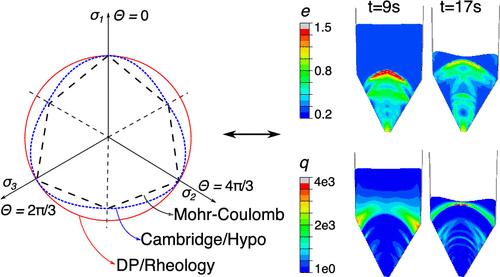当前位置:
X-MOL 学术
›
ACS Sustain. Chem. Eng.
›
论文详情
Our official English website, www.x-mol.net, welcomes your feedback! (Note: you will need to create a separate account there.)
A Review of Computational Models for the Flow of Milled Biomass Part II: Continuum-Mechanics Models
ACS Sustainable Chemistry & Engineering ( IF 8.4 ) Pub Date : 2020-04-15 , DOI: 10.1021/acssuschemeng.0c00412 Wencheng Jin 1 , Jonathan J. Stickel 2 , Yidong Xia 1 , Jordan Klinger 1
ACS Sustainable Chemistry & Engineering ( IF 8.4 ) Pub Date : 2020-04-15 , DOI: 10.1021/acssuschemeng.0c00412 Wencheng Jin 1 , Jonathan J. Stickel 2 , Yidong Xia 1 , Jordan Klinger 1
Affiliation

|
The design of efficient material-handling systems for milled lignocellulosic biomass is challenging due to their complex particle morphologies and frictional interactions. Computational modeling, including the discrete element method (DEM) and continuum-based finite-element/volume methods, may offer scientific insight and predictive capabilities for the flow of milled biomass in hoppers and feeders. This article (Part II) presents a review of current state-of-the-art continuum models for the flow of milled biomass, whereas DEM models are reviewed in a companion article (Part I). Advances of numerical methods to solve the global governing equations are discussed first, followed by a comprehensive review of constitutive models for granular materials, including Drucker–Prager, hypoplastic, Cambridge-type, inertial-rheology, and nonlocal granular fluidity models. Specifically, we provide in-depth discussion on the suitability of those models for milled lignocellulosic biomass materials in terms of nonlinear elasticity, dependence of flow strength on pressure, density and shear rate, and compaction (dilation) associated with hardening (softening). Our study shows that, despite the recent advances in continuum granular flow modeling, the most suitable constitutive models still need further development to account for material parametrization, multiflow regimes, and multiscale behavior before they can be reliably used to optimize the design and operation of biomass handling systems.
中文翻译:

研磨生物质流动的计算模型综述第二部分:连续体力学模型
由于木质纤维素生物质的复杂颗粒形态和摩擦相互作用,设计有效的物料处理系统具有挑战性。计算模型,包括离散元素方法(DEM)和基于连续体的有限元/体积方法,可以为粉碎的生物质在料斗和进料器中的流动提供科学的见识和预测能力。本文(第二部分)介绍了有关研磨生物质流的最新技术的连续模型,而DEM模型则在随附的文章中进行了回顾(第一部分)。首先讨论了求解全局控制方程的数值方法的进展,然后全面回顾了颗粒材料的本构模型,包括Drucker-Prager,塑性,剑桥型,惯性流变,和非局部颗粒流动性模型。具体来说,我们就非线性弹性,流动强度对压力,密度和剪切速率的依赖性以及与硬化(软化)相关的压实(膨胀)方面,就那些模型对碾碎的木质纤维素生物质材料的适用性进行了深入讨论。我们的研究表明,尽管最近在连续颗粒流模型方面取得了进展,但最合适的本构模型仍需要进一步发展以解决材料参数化,多流态和多尺度行为,然后才能可靠地使用它们来优化生物质的设计和运行处理系统。流动强度对压力,密度和剪切速率的依赖性,以及与硬化(软化)相关的压实(膨胀)。我们的研究表明,尽管最近在连续颗粒流模型方面取得了进展,但最合适的本构模型仍需要进一步发展以解决材料参数化,多流态和多尺度行为,然后才能可靠地使用它们来优化生物质的设计和运行处理系统。流动强度对压力,密度和剪切速率的依赖性,以及与硬化(软化)相关的压实(膨胀)。我们的研究表明,尽管最近在连续颗粒流模型方面取得了进展,但最合适的本构模型仍需要进一步发展以解决材料参数化,多流态和多尺度行为,然后才能可靠地使用它们来优化生物质的设计和运行处理系统。
更新日期:2020-04-23
中文翻译:

研磨生物质流动的计算模型综述第二部分:连续体力学模型
由于木质纤维素生物质的复杂颗粒形态和摩擦相互作用,设计有效的物料处理系统具有挑战性。计算模型,包括离散元素方法(DEM)和基于连续体的有限元/体积方法,可以为粉碎的生物质在料斗和进料器中的流动提供科学的见识和预测能力。本文(第二部分)介绍了有关研磨生物质流的最新技术的连续模型,而DEM模型则在随附的文章中进行了回顾(第一部分)。首先讨论了求解全局控制方程的数值方法的进展,然后全面回顾了颗粒材料的本构模型,包括Drucker-Prager,塑性,剑桥型,惯性流变,和非局部颗粒流动性模型。具体来说,我们就非线性弹性,流动强度对压力,密度和剪切速率的依赖性以及与硬化(软化)相关的压实(膨胀)方面,就那些模型对碾碎的木质纤维素生物质材料的适用性进行了深入讨论。我们的研究表明,尽管最近在连续颗粒流模型方面取得了进展,但最合适的本构模型仍需要进一步发展以解决材料参数化,多流态和多尺度行为,然后才能可靠地使用它们来优化生物质的设计和运行处理系统。流动强度对压力,密度和剪切速率的依赖性,以及与硬化(软化)相关的压实(膨胀)。我们的研究表明,尽管最近在连续颗粒流模型方面取得了进展,但最合适的本构模型仍需要进一步发展以解决材料参数化,多流态和多尺度行为,然后才能可靠地使用它们来优化生物质的设计和运行处理系统。流动强度对压力,密度和剪切速率的依赖性,以及与硬化(软化)相关的压实(膨胀)。我们的研究表明,尽管最近在连续颗粒流模型方面取得了进展,但最合适的本构模型仍需要进一步发展以解决材料参数化,多流态和多尺度行为,然后才能可靠地使用它们来优化生物质的设计和运行处理系统。

























 京公网安备 11010802027423号
京公网安备 11010802027423号